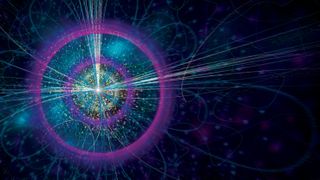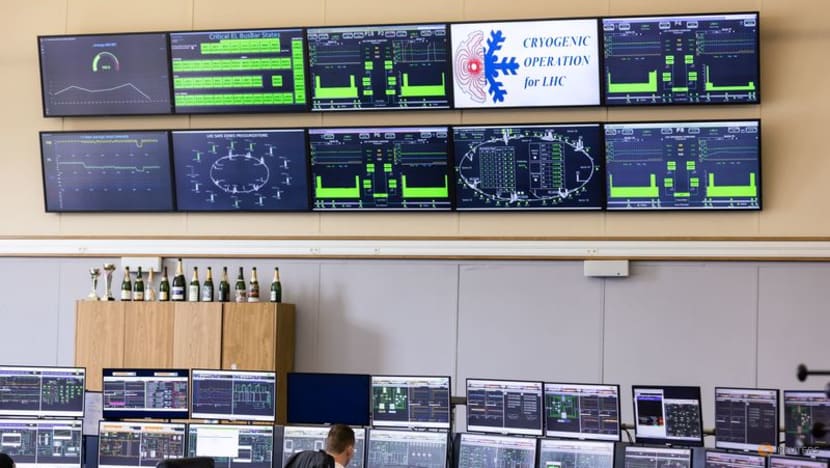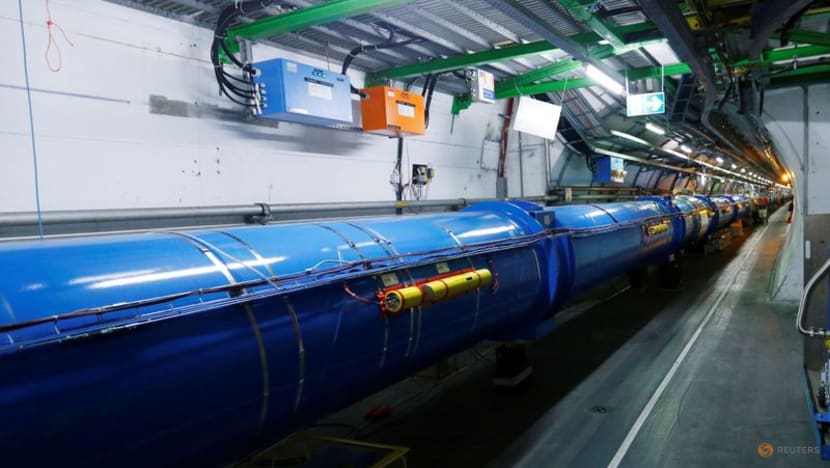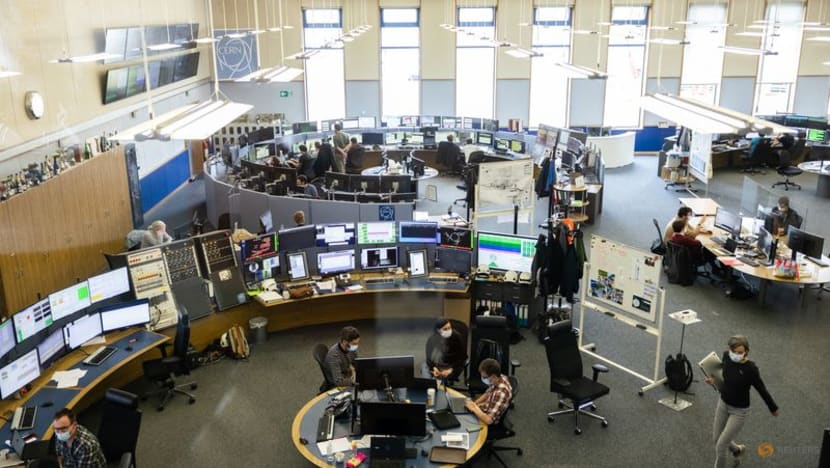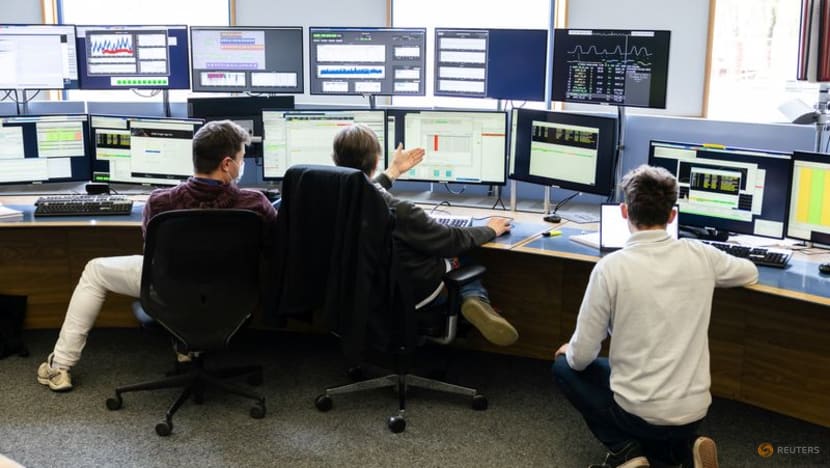CREATING QUANTUM REALITY
As the Large Hadron Collider Revs Up, Physicists’ Hopes Soar
The particle collider at CERN will soon restart. “There could be a revolution coming,” scientists say.
Inside the Large Hadron Collider near Geneva, a worker uses a bicycle to navigate its 17 miles of tunnels during maintenance in 2020.
Credit...Valentin Flauraud/Agence France-Presse — Getty Images
By Dennis Overbye
June 13, 2022
Sign up for Science Times Get stories that capture the wonders of nature, the cosmos and the human body. Get it sent to your inbox.
In April, scientists at the European Center for Nuclear Research, or CERN, outside Geneva, once again fired up their cosmic gun, the Large Hadron Collider. After a three-year shutdown for repairs and upgrades, the collider has resumed shooting protons — the naked guts of hydrogen atoms — around its 17-mile electromagnetic underground racetrack. In early July, the collider will begin crashing these particles together to create sparks of primordial energy.
And so the great game of hunting for the secret of the universe is about to be on again, amid new developments and the refreshed hopes of particle physicists. Even before its renovation, the collider had been producing hints that nature could be hiding something spectacular. Mitesh Patel, a particle physicist at Imperial College London who conducts an experiment at CERN, described data from his previous runs as “the most exciting set of results I’ve seen in my professional lifetime.”
A decade ago, CERN physicists made global headlines with the discovery of the Higgs boson, a long-sought particle, which imparts mass to all the other particles in the universe. What is left to find? Almost everything, optimistic physicists say.
When the CERN collider was first turned on in 2010, the universe was up for grabs. The machine, the biggest and most powerful ever built, was designed to find the Higgs boson. That particle is the keystone of the Standard Model, a set of equations that explains everything scientists have been able to measure about the subatomic world.
But there are deeper questions about the universe that the Standard Model does not explain: Where did the universe come from? Why is it made of matter rather than antimatter? What is the “dark matter” that suffuses the cosmos? How does the Higgs particle itself have mass?
Physicists hoped that some answers would materialize in 2010 when the large collider was first turned on. Nothing showed up except the Higgs — in particular, no new particle that might explain the nature of dark matter. Frustratingly, the Standard Model remained unshaken.

The control room of the European Center for Nuclear Research, or CERN, reopened in April.
Credit...Pierre Albouy/Reuters
The collider was shut down at the end of 2018 for extensive upgrades and repairs. According to the current schedule, the collider will run until 2025 and then shut down for two more years for other extensive upgrades to be installed. Among this set of upgrades are improvements to the giant detectors that sit at the four points where the proton beams collide and analyze the collision debris. Starting in July, those detectors will have their work cut out for them. The proton beams have been squeezed to make them more intense, increasing the chances of protons colliding at the crossing points — but creating confusion for the detectors and computers in the form of multiple sprays of particles that need to be distinguished from one another.
“Data’s going to be coming in at a much faster rate than we’ve been used to,” Dr. Patel said. Where once only a couple of collisions occurred at each beam crossing, now there would be more like five.
“That makes our lives harder in some sense because we’ve got to be able to find the things we’re interested in amongst all those different interactions,” he said. “But it means there’s a bigger probability of seeing the thing you are looking for.”
Meanwhile, a variety of experiments have revealed possible cracks in the Standard Model — and have hinted to a broader, more profound theory of the universe. These results involve rare behaviors of subatomic particles whose names are unfamiliar to most of us in the cosmic bleachers.
Take the muon, a subatomic particle that became briefly famous last year. Muons are often referred to as fat electrons; they have the same negative electrical charge but are 207 times as massive. “Who ordered that?” the physicist Isador Rabi said when muons were discovered in 1936.
Nobody knows where muons fit in the grand scheme of things. They are created by cosmic ray collisions — and in collider events — and they decay radioactively in microseconds into a fizz of electrons and the ghostly particles called neutrinos.
Last year, a team of some 200 physicists associated with the Fermi National Accelerator Laboratory in Illinois reported that muons spinning in a magnetic field had wobbled significantly faster than predicted by the Standard Model.
The discrepancy with theoretical predictions came in the eighth decimal place of the value of a parameter called g-2, which described how the particle responds to a magnetic field.
Scientists ascribed the fractional but real difference to the quantum whisper of as-yet-unknown particles that would materialize briefly around the muon and would affect its properties. Confirming the existence of the particles would, at last, break the Standard Model.

The Fermilab accelerator laboratory in Batavia, Ill. Fermilab’s Tevatron was the world’s most powerful collider until the Large Hadron Collider was built.
Credit...U.S. Department of Energy
But two groups of theorists are still working to reconcile their predictions of what g-2 should be, while they wait for more data from the Fermilab experiment.
“The g-2 anomaly is still very much alive,” said Aida X. El-Khadra, a physicist at the University of Illinois who helped lead a three-year effort called the Muon g-2 Theory Initiative to establish a consensus prediction. “Personally, I am optimistic that the cracks in the Standard Model will add up to an earthquake. However, the exact position of the cracks may still be a moving target.”
The muon also figures in another anomaly. The main character, or perhaps villain, in this drama is a particle called a B quark, one of six varieties of quark that compose heavier particles like protons and neutrons. B stands for bottom or, perhaps, beauty. Such quarks occur in two-quark particles known as B mesons. But these quarks are unstable and are prone to fall apart in ways that appear to violate the Standard Model.
Some rare decays of a B quark involve a daisy chain of reactions, ending in a different, lighter kind of quark and a pair of lightweight particles called leptons, either electrons or their plump cousins, muons. The Standard Model holds that electrons and muons are equally likely to appear in this reaction. (There is a third, heavier lepton called the tau, but it decays too fast to be observed.) But Dr. Patel and his colleagues have found more electron pairs than muon pairs, violating a principle called lepton universality.
“This could be a Standard Model killer,” said Dr. Patel, whose team has been investigating the B quarks with one of the Large Hadron Collider’s big detectors, LHCb. This anomaly, like the muon’s magnetic anomaly, hints at an unknown “influencer” — a particle or force interfering with the reaction.
One of the most dramatic possibilities, if this data holds up in the upcoming collider run, Dr. Patel says, is a subatomic speculation called a leptoquark. If the particle exists, it could bridge the gap between two classes of particle that make up the material universe: lightweight leptons — electrons, muons and also neutrinos — and heavier particles like protons and neutrons, which are made of quarks. Tantalizingly, there are six kinds of quarks and six kinds of leptons.
“We are going into this run with more optimism that there could be a revolution coming,” Dr. Patel said. “Fingers crossed.”
There is yet another particle in this zoo behaving strangely: the W boson, which conveys the so-called weak force responsible for radioactive decay. In May, physicists with the Collider Detector at Fermilab, or C.D.F., reported on a 10-year effort to measure the mass of this particle, based on some 4 million W bosons harvested from collisions in Fermilab’s Tevatron, which was the world’s most powerful collider until the Large Hadron Collider was built.

Paolo Girotti, a scientist at Fermilab, adjusting instruments with the Muon g-2 experiment in 2017.
Credit...Reidar Hahn/U.S. Department of Energy
According to the Standard Model and previous mass measurements, the W boson should weigh about 80.357 billion electron volts, the unit of mass-energy favored by physicists. By comparison the Higgs boson weighs 125 billion electron volts, about as much as an iodine atom. But the C.D.F. measurement of the W, the most precise ever done, came in higher than predicted at 80.433 billion. The experimenters calculated that there was only one chance in 2 trillion — 7-sigma, in physics jargon — that this discrepancy was a statistical fluke.
The mass of the W boson is connected to the masses of other particles, including the infamous Higgs. So this new discrepancy, if it holds up, could be another crack in the Standard Model.
Still, all three anomalies and theorists’ hopes for a revolution could evaporate with more data. But to optimists, all three point in the same encouraging direction toward hidden particles or forces interfering with “known” physics.
“So a new particle that might explain both g-2 and the W mass might be within reach at the L.H.C.,” said Kyle Cranmer, a physicist at the University of Wisconsin who works on other experiments at CERN.
John Ellis, a theoretician at CERN and Kings College London, noted that at least 70 papers have been published suggesting explanations for the new W-mass discrepancy.
“Many of these explanations also require new particles that may be accessible to the L.H.C.,” he said. “Did I mention dark matter? So, plenty of things to watch out for!”
Of the upcoming run Dr. Patel said: “It’ll be exciting. It’ll be hard work, but we are really keen to see what we’ve got and whether there is something genuinely exciting in the data.”
He added: “You could go through a scientific career and not be able to say that once. So it feels like a privilege.”
Dennis Overbye joined The Times in 1998, and has been a reporter since 2001. He has written two books: “Lonely Hearts of the Cosmos: The Story of the Scientific Search for the Secret of the Universe” and “Einstein in Love: A Scientific Romance.” @overbye
A version of this article appears in print on June 14, 2022, Section D, Page 4 of the New York edition with the headline: Hopes Soar as Collider Revs Up.
SEE




